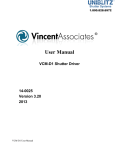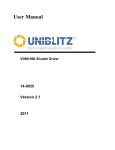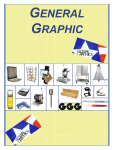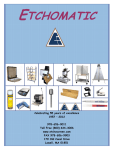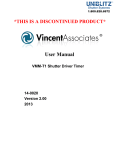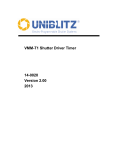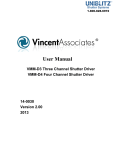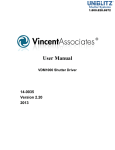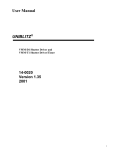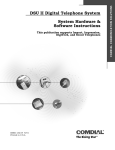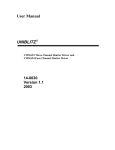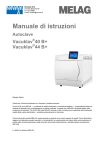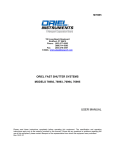Download User Manual VCM-D1 Shutter Driver
Transcript
User Manual UNIBLITZ® VCM-D1 Shutter Driver 14-0025 Version 2.0 2004 Vincent Associates products are covered by U.S. patents. Information in this publication supercedes that in all previously published material. Due to our ongoing development program, Vincent Associates reserves to right to discontinue or change specifications or designs, at any time, without incurring any obligation. Printed in the U.S.A. Version 2.0 2004 Vincent Associates, a Division of VA, Inc., 803 Linden Ave., Rochester, NY 14625 Tel: 585-385-5930 Fax: 585-385-6004 UNIBLITZ is a registered trademark of VA, Inc. VCM-D1 User Manual 2 WARRANTY All products manufactured by VINCENT ASSOCIATES are warranted to meet published specifications and to be free of defects in materials and workmanship as defined in the specifications for 365 (one year) days from the date of original shipment. MANUFACTURER will, at its own option, repair or replace without charge any listed item discovered to be defective. Burned out or otherwise damaged actuator coils are not covered under this warranty. The buyer’s exclusive remedy and the limit of MANUFACTURER’S liability for any loss whatsoever shall not exceed the purchase price paid by the buyer for the goods to which a claim is made. MANUFACTURER does not give any implied warranties of merchantability, fitness for a particular purpose, or of any other nature in connection with the sale of any products. The MANUFACTURER will consider the return of unused equipment if returned within 30 days from the original date of shipment, subject to a 20% restocking charge. This offer does not apply to used or damaged equipment. This warranty extends only to the original purchase and is not available to any third party, including any purchaser assemblies or other products of which the goods may become component equipment. This warranty does not extend to cover damage resulting from alteration, misuse, negligence, abuse, normal wear and tear, or accident. VCM-D1 User Manual 3 VCM-D1 User Manual 4 TABLE OF CONTENTS WARRANTY ................................................................................................................................................ 3 GENERAL SAFETY SUMMARY ............................................................................................................. 6 Injury Precautions ......................................................................................................................... 6 Product Damage Precautions ........................................................................................................ 6 Safety Terms and Symbols ............................................................................................................ 7 PREFACE ..................................................................................................................................................... 8 GETTING STARTED.................................................................................................................................. 9 Features........................................................................................................................................... 9 Introduction.................................................................................................................................. 10 Start Up......................................................................................................................................... 11 Line Fuse Replacement................................................................................................................ 11 Voltage Change............................................................................................................................. 12 Initial Operation and Testing...................................................................................................... 13 VCM-D1 FRONT PANEL OPERATOR CONTROLS .......................................................................... 15 Description.................................................................................................................................... 15 Figure #2 – VCM-D1 Front Panel Operator Controls.............................................................. 14 Notes .............................................................................................................................................. 17 VCM-D1 REAR PANEL OPERATOR CONTROLS............................................................................. 19 Description.................................................................................................................................... 19 Figure #4 – VCM-D1 Rear Panel Operator Controls and I/O ................................................. 18 OPERATING BASICS .............................................................................................................................. 21 Function Switches......................................................................................................................... 21 GATE INPUT ............................................................................................................................... 21 Gate Timing Diagrams................................................................................................................. 22 Figure #5A and 5B GATE Input Timing Diagram ................................................................... 22 Mode Selection.............................................................................................................................. 23 RS-232C Operation...................................................................................................................... 24 Figure #6 VCM-D1 Daisy Chain Cable Configuration............................................................. 25 RS-232 Test Program................................................................................................................... 26 Shutter Frequency of Operation ................................................................................................. 28 Trigger Cautions and Trouble Shooting Tips............................................................................ 28 Pulse Voltage Graphs................................................................................................................... 29 Figure #7 Pulse Voltage vs. Exposure Time............................................................................... 29 Figure #8 Pulse Voltage vs. Frequency....................................................................................... 29 Figure #9 Overall VCM-D1 Dimensions .................................................................................... 30 Maintenance ................................................................................................................................. 31 INSPECTION AND CLEANING ............................................................................................................. 31 General Care ................................................................................................................................ 31 Inspection and Cleaning Procedures .......................................................................................... 31 Inspection - Exterior .................................................................................................................... 32 Cleaning Procedure - Exterior .................................................................................................... 32 Cleaning Procedure – Interior .................................................................................................... 32 SPECIFICATIONS .................................................................................................................................... 33 INDEX ......................................................................................................................................................... 39 VCM-D1 User Manual 5 General Safety Summary Review the following safety precautions to avoid injury and prevent damage to this product or any products connected to it. To avoid potential hazards, use the product only as specified. Only qualified personnel should perform service procedures. Injury Precautions • Use proper Power Cord – To avoid fire hazard, use only the power cord supplied with this product. • Avoid Electric Overload – To avoid electrical shock or fire hazard, do not apply a voltage to a terminal that is outside the range specified for that terminal. • Avoid Electric Shock – To avoid injury or loss of life, do not connect or disconnect line cord while it is connected to the line voltage. • Ground the Product – This product is grounded through the grounding conductor of the power cord. To avoid electrical shock, the grounding connector must be connected to earth ground. Before making connections to the input or output terminals of the product, ensure that the product is properly grounded. DO NOT DEFEAT THE GROUND CONNECTION ON THE SUPPLIED LINE CORD. Access to On/Off Switch – Due to the position of the unit’s power switch at the rear panel, do not position the unit such that it is difficult to operate the on/off switch. • • Do Not Operate Without Cover – To avoid electric shock or fire hazard, do not operate this product with the cover removed. • Use Proper Fuse – To avoid fire hazard, use only the fuse type and rating specified for this product. • Do Not operate in Wet/Damp Conditions – To avoid electric shock, do not operate this product in wet or damp conditions. • Do Not Operate in an Explosive Atmosphere – To avoid injury or fire hazard, do not operate this product in an explosive atmosphere. Product Damage Precautions • Use Proper Power Source – Do not operate this product from a power source that applies more than the voltage specified. • Provide Proper Ventilation – To prevent product overheating, provide proper ventilation. • Do Not Operate with Suspected Failures – If you suspect there is damage to this product, have it inspected by qualified service personnel. VCM-D1 User Manual 6 Safety Terms and Symbols These terms appear in this manual WARNING Warning statements identify conditions or practices that could result in injury or loss of life. CAUTION Caution statements identify conditions or practices that could result in damage to this product or other property. These symbols appear on the equipment ATTENTION – Refer to user manual. VCM-D1 User Manual 7 Preface This Manual provides information for the VCM-D1 Shutter Driver. The manual contains the following chapters: • Getting Started contains a brief product description, information needed to power on the drivers, fuse replacement and voltage change information, and a brief procedure to verify that it functions. • Operator Controls provide an outline of the panel control functions and locations at the front and rear panels. This also includes the location and function of the input/output signals. • Operating Basics give further details to the operational features of the controllers. • Specifications are described for all input/output levels, including other pertinent details and information required for the RS-232 interface. • Index contains a full index. Following is the complete operators manual for the UNIBLITZ VCM-D1. Please read this manual completely before operating your unit. Due to the construction of this unit, we recommend that the unit be returned to the manufacturer for repair, no user serviceable parts inside. VCM-D1 User Manual 8 Getting Started Features The UNIBLITZ VCM-D1 replaces the VMM-D1 controller for those customers requiring CE/UL/CSA certification. The VCM-D1 contains all of the features of the VMM-D1, in addition to some new features, which enhance the units’ capability in even more demanding applications. These new features include: • UL/CSA certified and CE compliant. • An addressable RS-232 input through an RJ-45 input connector. Eight VCM-D1 units can also be daisy chained together by connecting the RJ-45 output to the RJ-45 input of the next controller within the chain. The user can select an address for each unit in the chain at the rear panel. • Switching capability on all input and output BNC connectors to provide either an active high or an active low, logic trigger level. • An AUX (auxiliary) output that can be toggled high to low and low to high by RS232 commands. • A GATE INPUT which will allow the user to select single (or multiple) trigger signal(s) from a stream of trigger signals. • A LOCAL/REMOTE switch which will effectively "disconnect" all input signals from the controller allowing the user to manually control the shutter without the need to remove the signals from the BNC inputs or the terminal strip - located at the front panel. RS-232C signals are also disabled in the LOCAL position. • A manually re-configurable AC input module. The user will need to manually reconfigure the unit for 230VAC operation. This AC input module includes the AC power cord input connector, power switch, dual ½ A “T” (slow blow) type 3AG line fuses (for 115VAC operation), line voltage change over fuse holder, and line filter. (For 230VAC operation user must change fuses to ¼ A “T” type 3AG line fuses.) • A switch to disable the Electronic Synchronization System of a shutter so equipped. • A new ODU type shutter output connector (push-lock type). • Enhanced CONTROL terminal at the front panel which now also includes the +5VDC and AUX outputs (which were located at the rear panel with the VMM-D1). All voltage outputs are internally fuse protected – not user serviceable. VCM-D1 User Manual 9 Introduction The UNIBLITZ VCM-D1 is capable of controlling all shutter types in the UNIBLITZ product line. The VCM-D1 has successfully completed and is compliant the tests listed under “APPLICABLE CERTIFICATIONS” on page #38 of this manual allowing it to be certified to CE/UL/CSA Safety and EMC certifications. The VCM-D1 incorporates a state of the art shutter driver while relying on the users input signal to determine exposure and frequency. One feature of the VCM-D1 is the selection of interrupt mode. With the mode switch in the “A” position, the unit will disable itself upon an AC line loss. When power is restored, the unit will remain disabled until reset. In the “B” position the unit will become disabled when a DC voltage level is removed from the interrupt input. When the input is restored, the unit will remain disabled until reset. The STD mode will bypass the interrupt capability. This mode selection makes the VCM-D1 more versatile for applications where the shutter must not re-open until acted upon by the user. Another added feature of this unit is the GATE INPUT, the GATE INPUT is used in conjunction with the TRIGGER INPUT. This input allows the user to “pick” one or a finite number of trigger pulses to trigger the controller from a continuous stream of pulses presented at the TRIGGER INPUT. This unit also contains an addressable RS-232 input. By connecting the RJ-45 OUTPUT of one controller to the RJ-45 INPUT connector of the next controller in the chain (using our 810RJ cable) multiple controllers can be connected together. In fact eight separate addresses allow up to eight units to be individually controlled via one computer serial port! The patented driver design of the VCM-D1 allows the controller to operate all shutter types in the UNIBLITZ product line. A 3 meter 7-pin (Wire-Pro) female to 7-pin (ODU push-lock) male shutter interconnect cable is also included with each unit (cable model number - 710B). VCM-D1 User Manual 10 Start Up After unpacking your unit inspect for any defects. If upon inspection a problem is found, or a part (or parts) are missing, notify Vincent Associates immediately. Be sure you are using the line cord provided with this unit. For Domestic (USA) the proper line cord is included. For Overseas (EU) a Standard European line cord is included in place of the domestic line cord. If the included EU line cord is not compatible, please use a line cord rated 230VAC, minimum 1A, and minimum 0.75 mm2 conductor size. The maximum cord length is 3 meters. After the initial inspection the unit is ready to use. To properly install and power on the VCM-D1, perform this procedure. 1. Check that you have the proper electrical connections. The rear label, which covers the AC input module, is there to remind you to manually configure the AC input module if the unit requires operation at 230VAC. See “Voltage Change” instructions. THIS LABEL MUST BE REMOVED PRIOR TO INSERTING THE POWER CORD INTO THE AC INPUT CONNECTOR REGARDLESS OF WHICH AC VOLTAGE LEVEL IS USED. 2. Check the line fuses to be sure they are the proper rating. The VCM-D1 has been shipped with the proper fuses for 115VAC operation (3AG ½ A “T” type - time-lag). For 230VAC operation, change line fuses to the 5mm x 20mm ¼ A time-lag (supplied w/unit, packaged separately). See “Line Fuse Replacement” instructions. 3. Be sure the AC module power switch is toggled to the “0” position and the power end of the line cord is not connected to the AC line. Then connect the opposite end of the supplied line cord to the rear panel AC module connector. Be sure the cord is inserted completely into the AC module connector. 4. Connect the power end of the line cord to the AC line. Power unit ON by toggling the AC module power switch to the “1” position. Power LED indicator will illuminate. 5. Due to the position of the unit’s power switch at the rear panel, do not position the unit such that it is difficult to operate the on/off switch. Line Fuse Replacement WARNING To avoid injury or death, unplug the line cord from the line voltage power source before continuing. 1. Have handy a small flat-bladed screwdriver or similar tool and refer to Figure #1. 2. Set the VCM-D1 unit so that the rear panel is facing you. 3. BE SURE THE LINE CORD IS DISCONNECTED FROM THE LINE VOLTAGE POWER SOURCE. Unplug the line cord from the AC module connector. You cannot proceed with this procedure without removing the line cord from the VCM-D1 control unit. VCM-D1 User Manual 11 4. Using the small flat bladed screwdriver or similar tool; insert the tool into the cover door slot; pry open cover door. 5. Using the same tool; insert the tool into the fuse holder slot; pry out the fuse holder block. 6. Remove defective fuse(s); replace with new fuse(s) and replace fuse holder into housing; close the cover door. Voltage Change To avoid injury or death, unplug the line cord from the line voltage power source before continuing. WARNING 1. Repeat steps 1-5 in “Line Fuse Replacement” instructions and refer to Figure #1. 2. Rotate the fuse holder block 180°; if changing to 230VAC, replace fuses with two 5mm x 20mm ¼ A “T” type (time-lag) fuses. (Be sure to change fuses back to 3AG ½ A time-lag fuses when changing back to 115VAC). 3. Replace fuse holder block and close the cover door. The desired voltage will be indicated and appear in the cover door window. FUSE HOLDER FUSE HOLDER SLOT 115V 230V PRSR FUSE #2 FUSE #1 (SAME POSITION OPPOSITE SIDE OF FUSE #2) COVER DOOR SLOT COVER DOOR WINDOW COVER DOOR Figure #1 - AC Input Module VCM-D1 User Manual 12 Initial Operation and Testing The VCM-D1 will operate from 115VAC or 230VAC (50-60Hz), this is manually selectable. CAUTION *PLEASE BE SURE THAT THE UNIT IS PROPERLY SET UP FOR THE LINE VOLTAGE TO BE USED.* Once the line cord has been attached to unit and connected to properly grounded wall receptacle, the unit may be operated. CAUTION *BE SURE POWER SWITCH IS IN THE OFF POSITION BEFORE CONNECTING PLUG TO LINE. ATTACH LINE CORD TO THE UNIT FIRST BEFORE PLUGGING INTO THE AC POWER SOURCE.* See “Start Up” section. Insert the 7- pin male ODU type connector of shutter interconnect cable into 7- pin female ODU type receptacle at rear of unit labeled SHUTTER. Connect the 7- pin female Wire-Pro connector of shutter interconnect cable to 7- pin male WirePro connector on shutter to be driven. Place POWER switch to the ON “1” position, the POWER LED will illuminate. Place the N.O./N.C. switch into the N.O. position. The shutter will open and remain open until the switch is returned to the N.C. position. The SHUTTER ACTIVE LED will illuminate when this switch is in the N.O. position. All UNIBLITZ drivers provide the circuitry necessary to support shutters equipped with the solid state synchronization option. Simply plug the shutter interconnect cable into the driver. If your shutter is equipped with this option the green LED, labeled SYNC ACTIVE, will illuminate when the shutter is in the open position. In addition, the SYNC output will change to the active state when the shutter is open. The absence of the solid state synchronization option will only inhibit the operation of the SYNC output and SYNC ACTIVE LED. The remainder of the VCM-D1 systems will not be affected. In addition the SYNC system can be disabled by sliding the “G” FUNCTION switch to the upper position. See specifications and operator controls for additional operational information concerning other systems of the VCM-D1. CAUTION Should the shutter and/or control not respond as described previously, be sure line cord is installed into the receptacle and connections to the shutter are made properly. Note that the shutter output is also fused (located at the front panel - .6A time-lag). TURN OFF THE UNIT AND REMOVE THE PLUG FROM THE AC SOURCE BEFORE CHECKING FOR BLOWN FUSES. Be advised, a visual inspection of a fuse is usually NOT an adequate test to determine if a fuse failure has occurred. Use a DMM (Digital Multi-Meter) or equivalent test device to determine fuse continuity. Also, particular shutter units respond to different minimum pulse widths. For example, a standard VS25 shutter has a minimum exposure pulse of 6ms, if the timing is set for an exposure pulse width less than 6ms, the shutter may not open fully. If the unit still does not operate properly, please notify Vincent Associates immediately. VCM-D1 User Manual 13 Figure #2 – VCM-D1 Front Panel Operator Controls VCM-D1 User Manual 14 +10V MODE CONTROL STD A +5V B ® MODEL VCM-D1 SHUTTER DRIVER ® SHUTTER FUSE 0.6A T POWER REMOTE LOCAL N.O. N.C. RESET DISABLED SYNC DRIVER VCM-D1 Front Panel Operator Controls Description (Refer to Figure #2) 1. CONTROL Terminal block. The five position terminal block referred to on the driver (and throughout this manual) as CONTROL provide access to several of the input and output connections for external operation of your driver. Each terminal is explained below: a. CONTROL #1 Output. +10VDC provided for remote switching applications or control circuits. b. CONTROL #2 Pulse In. Active high input to control shutter exposure for duration of positive pulse, or electronic or mechanical switch contact closure. Shutter will follow pulse and frequency applied to this input. (This will operate the same as the PULSE IN BNC set to the active high mode.) c. CONTROL #3 GND. This convenient ground point allows user to connect input or output signals to ground (common) the VCM-D1 circuit. d. CONTROL #4 Input. DC interrupt voltage. With key switch set to mode B, the interrupt will be activated when input DC voltage (+8VDC min.) is disrupted via a switch, transistor, or similar method. This input is for DC voltage only. e. CONTROL #5 Output. When interrupt is activated, this normally low output is high until reset deactivates the interrupt. f. CONTROL #6 AUX Output. The VCM-D1 AUX output is an active low pulse output that can be toggled TTL high and low from commands presented to the RS232C control input. See “AUX Out (CONTROL pin 6)” under EXTERNAL OUTPUT CHARACTERISTICS. g. CONTROL #7 Output. +5V is provided for remote switching applications or control circuits. 2. MODE Keyswitch. The position of the key switch sets the mode of interrupt. The interrupt switch disables the shutter driver when a voltage interrupt is detected, either AC or DC. Upon reset, the shutter will return to the position set by an external input or the position of the N.O./N.C toggle switch. a. A (AC interrupt mode). Prevents the driver from re-opening the shutter immediately upon power-up if the line voltage were to be interrupted. The driver remains disabled until user supplies reset by specified means. b. B (DC interrupt mode). When the key switch is in Position B the driver will become disabled when it detects that the DC input voltage at CONTROL #4 has been removed or disrupted. When the voltage level is re-applied, the driver remains disabled until reset. The DC input voltage is supplied (from CONTROL #1) or from an external source, determined by the user. c. STD The STD mode bypasses the driver's interrupt capabilities. CONTROL #4 and CONTROL #5 become inactive. The VCM-D1 will not remain disabled after a disruption in line voltage. VCM-D1 User Manual 15 3. SYNC. ACTIVE LED indicator. Indicates status of Solid State Sync. output. The green LED is illuminated when shutter's electronic sync. is activated. (This LED functions only if the shutter used is equipped with the Solid State Sync. system.) 4. DRIVER ACTIVE LED indicator. This LED indicates when the internal shutter driver circuit input has an active signal present. 5. DISABLED Indicator. Indicates that one of the two interrupt modes (mode A or mode B) has disabled the driver. LED is off after reset, and STD operation. 6. RESET Momentary Pushbutton Switch. Resets VCM-D1 disabled by interrupts (mode A or mode B) and returns shutter to the position determined by the N.O./ N.C., or the status of the PULSE input. (The TRIGGER flip-flop is also reset. If the shutter had been activated by this input the shutter will close after a reset pulse.) Please note if an open command is sent to the RS-232 input, a reset command will not clear the RS-232 output and the shutter will not close. You must send a close command to allow the shutter to close. If you wish to have the shutter close (or return to the state as set by the N.O./N.C. switch) with a reset command or the RESET switch, you must open the shutter with a trigger command. 7. LOCAL/REMOTE Toggle switch. When in the LOCAL position all inputs to the unit are effectively "disconnected” allowing the user to manually control the shutter without the need to remove the signals from the BNC inputs or the terminal strip (located at the front panel). In the REMOTE position, the unit will function normally. RS-232C signals are also disabled with this switch in the LOCAL position. 8. POWER LED indicator. 9. SHUTTER FUSE. Replace with 5mm x 20mm .6A time-lag fuse. This fuse may fail if the shutter is operated at an excessive frequency and duty cycle to protect the coil from premature failure. If the operation of the shutter used is causing “nuisance blowing” of this fuse, please contact technical support to discuss your application. 10. N.O./N.C. Toggle switch. The position of this switch determines shutter status BEFORE a trigger signal is received by VCM-D1. In the N.C. position the shutter will be activated open by an input pulse signal. In the N.O. position the shutter will be activated closed. The N.O./N.C switch acts to invert the shutter operation. Any RESET command will return the shutter to the position determined by the N.O./N.C. switch. Please note if an open command is sent to the RS232 input, a reset command will not clear the RS-232 output and the shutter will not close. You must send a close command to allow the shutter to close. If you wish to have the shutter close (or return to the state as set by the N.O./N.C. switch) with a reset command or the RESET switch, you must open the shutter with a trigger command. VCM-D1 User Manual 16 Notes VCM-D1 User Manual 17 Figure #4 – VCM-D1 Rear Panel Operator Controls and I/O VCM-D1 User Manual 18 VCM-D1 Rear Panel Operator Controls Description (Refer to Figure #4) 1. ADDRESS SELECT switch. Rotation of the 8 position octal rotary switch selects the active RS232C address of the unit. See “ADDRESS Select” under GENERAL CHARACTERISTICS. 2. PULSE INPUT BNC. Allows control of the shutter exposure and frequency from a TTL signal source. The pulse duration determines the shutter exposure interval. The frequency of the signal presented to this input determines the frequency of shutter exposures. This input can be set active high or active low by FUNCTION switch B. See “FUNCTION Select” under GENERAL CHARACTERISTICS. 3. RS-232C Dual RJ45 female connectors. Provides access to the VCM-D1 RS-232C interface allowing the user to control input functions via commands sent from a computer RS-232C serial port. The INPUT connector accepts commands directly from a computer’s serial port or from another VCM-D1 in the daisy chain. The OUTPUT connector allows the controller to send commands to the next controller in the daisy chain. For further reference see Figure #6 on page #25. See also RS-232C INPUT (Dual RJ45) under EXTERNAL INPUT SPECIFICATIONS (page #34) and RS-232C OUTPUT (Dual RJ45) under EXTERNAL OUTPUT SPECIFICATIONS (page #35). 4. TRIGGER INPUT BNC. Allows for pulsed open/pulsed close shutter operation. Opens the shutter on the first pulse trigger edge, closes the shutter on the next trigger edge. This input operates in conjunction with the GATE INPUT. When the GATE INPUT is active, the TRIGGER INPUT will be enabled. This input can be set active high or active low by FUNCTION switch A. See “FUNCTION Select” under GENERAL CHARACTERISTICS. 5. RESET INPUT BNC. Resets the VCM-D1 disabled by an interrupt (MODE A or MODE B) when switched to ground level via TTL logic or simply shorting to ground through a switch contact. TTL logic pulse returns the shutter to the position determined by the N.O./N.C. toggle switch. When the shutter is opened via the TRIGGER INPUT, a TTL pulse presented to the RESET input will close the shutter. Please note if an open command is sent to the RS-232 input, a reset command will not clear the RS-232 output and the shutter will not close. You must send a close command to allow the shutter to close. If you wish to have the shutter close (or return to the state as set by the N.O./N.C. switch) with a reset command, you must open the shutter with a trigger command. This input can be set active high or active low by FUNCTION switch C. See “FUNCTION Select” under GENERAL CHARACTERISTICS. 6. GATE INPUT BNC. An active signal present at this input will enable trigger signals presented to the TRIGGER INPUT. (An unused GATE INPUT is in the active state.) When this signal goes inactive, the TRIGGER INPUT will disable. In this way, the user can effectively “gate” a stream of trigger pulses and allow one or more to be received, as determined by the user, by the VCM-D1. Therefore, this input can be used to “pick” a pulse or pulses from a series of trigger pulses presented to the TRIGGER INPUT. This input must be used in conjunction with the TRIGGER INPUT. This input can be set active high or active low by FUNCTION switch D. See “FUNCTION Select” under GENERAL CHARACTERISTICS. VCM-D1 User Manual 19 7. SHUTTER Output 7-pin ODU female push-lock type receptacle. 7-pin female ODU type connector to mate with 7-pin ODU male plug of the 710B 10’ interconnect cable included with the unit. Pin out as follows, wire colors indicate 710B cable and shutter wiring layout: a. b. c. d. e. f. g. ODU Pin 2 Pin 3 Pin 4 Pin 5 Pin 6 Pin 1 Pin 7 Description Shutter Actuator Coil Drive Output Shutter Actuator Coil Drive Output Sync. Emitter Diode Output Circuit Ground Sync. Detector Transistor Input +5.0VDC Power Supply Output Shutter Ground Shutter Red Brown White Green Yellow Blue Black 710B Red Brown White Green Orange Blue Black Wire-Pro Pin A Pin B Pin C Pin D Pin E Pin F Pin H 8. 115 VAC 60Hz. /230 VAC 50Hz. Input module. Mates with female IEC plug on supplied line cord. Includes the following additional functions: a. b. c. d. Power switch – “0” is off, “1” is on. Power fuses: ½Amp SB for 115 VAC 60Hz., ¼Amp SB for 230 VAC 50Hz. See “Line Fuse Replacement” instructions. Voltage change switchover block. See “Voltage Change” instructions. 3A line filter. (Internal, not user accessible) 9. FUNCTION switches. Eight sub-miniature slide switches. A-D switches are used to select the active states of each of the four input BNC input connectors. E-F switches are used to select the active states of each of the two output BNC output connectors. (See “FUNCTION select” under GENERAL CHARACTERISTICS.) The G switch allows the user to disable the electronic sync circuit. Slide switch to the up position to disable the electronic sync. This shuts off the infrared emitter internal to the shutter which intern disables the SYNC OUTPUT. The H switch is used to select the proper pulse energy for the shutter being driven. Switch to the HIGH (up) position for the VS35 (35mm aperture), the CS45 (45mm aperture), the CS65 (65mm aperture) and larger aperture shutters types, switch to the LOW (down) position for all other shutter types. 10. SYNC. OUTPUT BNC. Output for shutters equipped with the SOLID STATE SYNCHRONIZATION SYSTEM option. The shutter’s internal sync. circuit sets the BNC to a low level when the sync. circuit becomes active. The output goes low when the shutter reaches 80% of full open, and goes to the high state when the shutter reaches 20% closed. The front panel SYNC. ACTIVE LED illuminates when the sync. is active. This output can be disabled with the G FUNCTION switch – see #9 above. This input can be set active high or active low by FUNCTION switch F. See “FUNCTION Select” under GENERAL CHARACTERISTICS. 11. PULSE OUTPUT BNC. The duration of this pulse is equal to the duration of the shutter exposure pulse. This output can be used to daisy chain VCM-D1 units together. A TTL exposure pulse input to the PULSE INPUT BNC will appear at the PULSE OUTPUT BNC. Note toggling the N.O./N.C. will not change the state of the PULSE OUTPUT. This input can be set active high or active low by FUNCTION switch E. See “FUNCTION Select” under GENERAL CHARACTERISTICS. VCM-D1 User Manual 20 Operating Basics Refer to the section describing the “Initial Operation and Testing” for initial preparation to put your VCM-D1 into operation. Function Switches Located at the Rear Panel and labeled “Function” are eight miniature slide switches. Switches A – F allow the user to select the active state of the four BNC inputs and two BNC outputs. When the switch actuators are selected to the down position (a small hole will be visible just above the switch’s actuator, this actuator could be either black or red), the corresponding BNC input or output will be TTL active low. This indicates that a logic “0” (0 volts) will activate the selected input or what the output will switch to when active. The switches must be in this (the active low) position to activate the inputs from a remote activate cable such as the 710R (handheld) or the 710R/F (foot activated). CAUTION DO NOT CONNECT A 710R OR 710R/F TO AN OUTPUT. THE OUTPUT COULD BECOME DAMAGED. By sliding any of these switch actuators to the up position (covering the small hole), the selected BNC input will become TTL active high. This indicates that a logic “1” (+5 volts) will activate the selected input or produce an active high output. Switch G will allow the user to disable the electronic sync circuit. Slide switch to the up position to disable the electronic sync. This shuts off the infrared emitter internal to the shutter which intern disables the SYNC OUTPUT. Switch H selects HIGH/LOW pulse energy. HIGH energy is required to operate the VS35 (35mm aperture) and larger aperture shutters. When the switch is in the down (Lower) position (a small hole will be visible just above the switch’s actuator, this actuator could be either black or red), the pulse energy is selected LOW. When the switch actuator is in the up (Upper) position (covering the small hole), the pulse energy is selected HIGH. CAUTION THE HIGH ENERGY SETTING MUST BE USED FOR ONLY THE VS35 AND LARGER APERTURE SHUTTERS. USE THE LOW POSITION FOR ALL OTHER UNIBLITZ SHUTTERS. USE OF THE HIGH POSITION FOR SHUTTER APERTURES SMALLER THAN THE VS35 AND LARGER APERTURE DEVICES COULD CAUSE IRREPARABLE DAMAGE TO THE SHUTTER USED AND WILL VOID THE SHUTTER’S LIMITED WARRANTY. GATE INPUT The GATE INPUT is used in conjunction with the TRIGGER INPUT. This input allows the user to “pick” one or a finite number of trigger pulses to trigger the controller from a continuous stream of pulses presented at the TRIGGER INPUT. See Figure #5. The following description assumes the GATE INPUT is selected active high (function switch ”D” up position) and the TRIGGER INPUT is selected to the active low state (function switch “A” down position). When a stream of trigger pulses is input to the TRIGGER INPUT and the GATE INPUT is in the high state (TTL logic “1”, +5V), the trigger signals will operate the VCM-D1 as described in the VCM-D1 User Manual 21 “OPERATOR CONTROLS” section. Once the GATE INPUT changes to the low state (TTL logic “0”, 0V), all trigger signals being sent to the TRIGGER INPUT are disabled. A single TTL high pulse presented to the GATE INPUT, equal to the trigger period, will allow one trigger signal from the trigger stream to be enabled. (See Figure #5A.) If a single TTL high pulse presented to the GATE INPUT is equal to twice the trigger period, two trigger signals from the trigger stream are enabled. (See Figure #5B.) Therefore, the number of trigger pulses input (or GATE INPUT duration) is equal to the trigger period times the number of exposures desired. The VCM-D1 TRIGGER INPUT opens the shutter with the first pulse presented to the input and closes the shutter on the subsequent pulse. Gate Timing Diagrams TRIGGER PERIOD TRIGGER SIGNAL STREAM (ACTIVE LOW) HIGH GATE PULSE GATE SIGNAL (ACTIVE HIGH) ACTIVE HIGH PULSE WIDTH EQUAL TO TRIGGER PERIOD LOW GATE PULSE SINGLE PULSE ALLOWED TO TRIGGER UNIT TRIGGER PULSE (A) TRIGGER PERIOD TRIGGER SIGNAL STREAM (ACTIVE LOW) ACTIVE HIGH PULSE WIDTH EQUAL TO 2X TRIGGER PERIOD HIGH GATE PULSE GATE SIGNAL (ACTIVE HIGH) LOW GATE PULSE 2 TRIGGER PULSES TWO PULSES ALLOWED TO TRIGGER UNIT (B) Figure #5A and 5B GATE Input Timing Diagram VCM-D1 User Manual 22 Mode Selection The VCM-D1 mode of operation can be selected with the key switch located on the front panel. The key can be removed in any position thus preventing the switch from inadvertently being changed while in operation. This will ensure that if an interrupt is set, the shutter will not return to its original state until the VCM-D1 unit is reset (by any of a number of methods). In the “A” mode the unit will operate normally until loss of AC line voltage. When the AC voltage is restored, the DISABLED LED will be illuminated and CONTROL #5 will be active high. When reset (by any means enumerated in the SPECIFICATION section) the unit will return to its original state. Be advised that when the key switch is switched from the STD mode to the “A” mode the unit will be disabled initially. A reset will return the controller to its operating state. In the “B” mode the unit will operate normally until a loss of DC voltage to the CONTROL #4 input. A complete circuit must be made from either CONTROL #1 (+10VDC) or an External power source to the CONTROL #4 input. When the power source is removed from the CONTROL #4 input, the unit will be disabled and the DISABLED LED will be illuminated if and only if the input is restored. When the input voltage is restored the DISABLED LED will be illuminated and the CONTROL #5 will be active high. When reset (by any means enumerated in the SPECIFICATION section) the unit will return to its original state. (Please note that in this mode, a loss of AC voltage will also disable the unit, as an added safety feature.) The shutter’s original state can be set by the N.O./N.C. switch or by an external input signal. If the shutter has been opened by an RS-232 open command, and a “B” interrupt occurs, upon a reset, the shutter’s state will be restored. Only a close command will close the shutter. If an “A” interrupt occurs, when power is restored, the RS-232 system is reset and the shutter will be closed (this assumes a normally closed shutter type). If the shutter has been opened by the TRIGGER INPUT or an RS-232 trigger command, and an “A” or “B” interrupt occurs, when the unit is reset, the shutter will close. A new command will need to be input to re-open the shutter. In the STD mode all functions of the interrupt will be disabled and the unit will operate from all system controls and inputs. VCM-D1 User Manual 23 RS-232C Operation The VCM-D1 inputs can be controlled via an RS-232C computer serial signal (COM port). From your computer's RS-232C serial port, connect a cable (such as the 810RJ cable or a user-constructed cable with connections as enumerated in the INPUT SPECIFICATIONS) to your unit's RS-232C interface.. The RS-232 input is configured in the null modem configuration. Connect the Tx (transmit) from the host to the Rx (receive) on the VCM-D1 control unit. All other lines are not used except for the Ground connection. When using the 810RJ cable the 910RJF Adapter is required to connect the VCM-D1 to the host computer. If the host contains a 25-Pin D-sub or an 8-Pin MiniDIN, check your computer's user's manual to find the proper corresponding pin outs and a cable will need be connected or a proper adapter purchased to connect the 810RJ to the host. In most cases the corresponding 25-Pin D-Sub pin out and MAC 8-Pin Mini-DIN are as follows: Function RJ-45 INPUT RJ-45 IBM OUTPUT DB-9M Rx Receive Data Tx Transmit Data GND Signal Ground Pin 5 Pin 6 Pin 4 Pin 5 Pin 6 Pin 4 Pin 2 Pin 3 Pin 5 IBM MAC DB-25M Mini-DIN-8F Pin 3 Pin 2 Pin 7 Pin 5 Pin 3 Pin 4 All other pins not used. Be sure to connect the Tx pin, Pin 3 from the IBM 9-Pin D-Sub (or Pin 2 from the 25-Pin D-Sub) male connector to the Rx pin, Pin 5 of the VCM-D1 RJ-45 INPUT connector (located at the rear panel) for proper operation. Connect all other functions as indicated above. By sending the proper commands, the unit will respond by activating the proper function. The program listed on page 31 will allow operation of the VCM-D1 from the computer keyboard. With activation of the shutter with a trigger command through the RS-232 interface, a reset command from the control unit's front panel, through the RESET INPUT on the rear panel, a reset command through the RS-232, or a subsequent trigger command from the RS-232 will deactivate the shutter. When an open command is sent to either controller, a reset command will not close the shutter. The shutter must be closed with a close command. Up to eight VCM-D1 can be daisy chained together (connected through the same serial port) using the 810RJ cable. One cable is required for each controller in the chain. See Figure #6. Figure #6 illustrates connecting two controllers from a single serial port. Once connected, each unit will require a unique address in the chain. This is accomplished by adjusting the octal switch beneath the dual RJ-45 connectors on the rear panel to the desired command range. (See “ADDRESS Select” under GENERAL CHARACTERISTICS in the SPECIFICATIONS section for a complete listing of the command range for each octal switch position.) The specific command range sent will decode commands sent via the serial port. A set of “ALL” commands is also available to control all units connected to the serial port. VCM-D1 User Manual 24 TO NEXT CONTROLLER (INPUT) T P OM OC E UT RS IAL ER PO RT 910RJF ADAPTER 810RJ CABLE Address Select Switch 810RJ CABLE Figure #6 VCM-D1 Daisy Chain Cable Configuration The following is a test program written to test the input commands to the RS-232 interface of the VCM-D1 controllers. (This program and LabView programs (not listed) are available by downloading from the resource section of our web site (www.UNIBLITZ.com), request via e-mail ([email protected]), or calling (800) 828-6972.) Other programs may be available, please contact technical support for further information. VCM-D1 User Manual 25 RS-232 Test Program REM PROGRAM TO SEND DECIMAL COMMANDS TO RS232 INTERFACE, XILINX CPLD. REM WRITTEN BY RICHARD ST.LOUIS, VINCENT ASSOCIATES. REM LAST REVISION 5/13/2003 CLS 0 K = -1 WHILE K OPEN "COM1:9600,N,8,1,CS0,DS0" FOR RANDOM AS #1 J = 64 C$ = "X" MENU: PRINT PRINT PRINT PRINT "WAITING FOR KEYSTROKE COMMAND " PRINT "TYPE:" PRINT " VCM-D1 " PRINT " -------" PRINT " O - OPEN Shutter " PRINT " C - CLOSE Shutter " PRINT " T - TRIGGER Control " PRINT " R - RESET Control " PRINT " E - ENABLE Aux-Out " PRINT " D - DISABLE Aux-Out " PRINT " G - GATE On " PRINT " F - GATE Off " PRINT PRINT " S - SET Octal Switch Address " PRINT " (Current Starting Decimal # ="; J; ")" PRINT " (Current Octal Address Value = "; C$; ")" PRINT PRINT " Q - QUIT Program " PRINT PRINT START: A$ = INKEY$ IF A$ = "O" OR A$ = "o" THEN PRINT #1, CHR$(J); PRINT "SHUTTER OPEN COMMAND SENT" GOSUB TIMEOUT GOTO MENU ELSEIF A$ = "C" OR A$ = "c" THEN PRINT #1, CHR$(J + 1); PRINT "SHUTTER CLOSE COMMAND SENT" GOSUB TIMEOUT GOTO MENU ELSEIF A$ = "T" OR A$ = "t" THEN PRINT #1, CHR$(J + 2); PRINT "CONTROL TRIGGER COMMAND SENT" GOSUB TIMEOUT GOTO MENU ELSEIF A$ = "R" OR A$ = "r" THEN PRINT #1, CHR$(J + 3); PRINT "CONTROL RESET COMMAND SENT" GOSUB TIMEOUT GOTO MENU ELSEIF A$ = "E" OR A$ = "e" THEN PRINT #1, CHR$(J + 4); PRINT "ENABLE AUX COMMAND SENT" GOSUB TIMEOUT GOTO MENU ELSEIF A$ = "D" OR A$ = "d" THEN PRINT #1, CHR$(J + 5); PRINT "DISABLE AUX COMMAND SENT" VCM-D1 User Manual 26 GOSUB TIMEOUT GOTO MENU ELSEIF A$ = "G" OR A$ = "g" THEN PRINT #1, CHR$(J + 6); PRINT "GATE ON COMMAND SENT" GOSUB TIMEOUT GOTO MENU ELSEIF A$ = "F" OR A$ = "f" THEN PRINT #1, CHR$(J + 7); PRINT "GATE OFF COMMAND SENT" GOSUB TIMEOUT GOTO MENU ELSEIF A$ = "Q" OR A$ = "q" THEN K=0 PRINT "PROGRAM TERMINATED" ELSEIF A$ = "S" OR A$ = "s" THEN INPUT "ENTER OCTAL ADDRESS 0 - 7 or X: ", B$ GOSUB ADDRESS GOTO MENU ELSE GOTO START END IF WEND END TIMEOUT: FOR I = 1 TO 100: NEXT I CLS 0 RETURN ADDRESS: IF B$ = "X" OR B$ = "x" THEN J = 64 C$ = "X" ELSEIF B$ = "0" THEN J = 128 C$ = "0" ELSEIF B$ = "1" THEN J = 144 C$ = "1" ELSEIF B$ = "2" THEN J = 160 C$ = "2" ELSEIF B$ = "3" THEN J = 176 C$ = "3" ELSEIF B$ = "4" THEN J = 192 C$ = "4" ELSEIF B$ = "5" THEN J = 208 C$ = "5" ELSEIF B$ = "6" THEN J = 224 C$ = "6" ELSEIF B$ = "7" THEN J = 240 C$ = "7" ELSE J = 64 C$ = "X" END IF PRINT "STARTING ASCII DECIMAL # = ", J GOSUB TIMEOUT CLS 0 RETURN VCM-D1 User Manual 27 Shutter Frequency of Operation The repeat exposure specification as listed in this manual is specified at 35ms. This is an optimum value to ensure enough pulse energy to open any UNIBLITZ shutter. However the VCM-D1 is capable of operating each Vincent shutter to its maximum frequency with a slight sacrifice in shutter opening speed. This is due to the drive circuit, which allows the pulse voltage to drop with an increase in frequency to compensate for the heat that is developed in the shutter coil. (See graphs Figure #7 and 8) Please contact the factory for specific information concerning shutter modifications and/or drive modifications that may be necessary for operating shutters at their maximum frequency. Please note also that fuse blowing problems, specifically shutter fuses, may be due to high frequency operation without proper fuse selection. Due to the large number of different frequencies and duty cycles that the shutter is used with, please contact the factory for further details regarding specific fuse selection. Trigger Cautions and Trouble Shooting Tips 1. The VCM-D1 system's capability can be greatly enhanced by external control as described previously, however, extreme care must be taken to ensure that high voltages (see SPECIFICATIONS) are not inadvertently switched into external control inputs. Also, note that large negative voltages can cause irreparable damage to the unit's internal circuitry. Exercise extreme caution. 2. As noted previously, a visual inspection of a fuse is usually NOT an adequate test to determine if a fuse failure has occurred. Use a DMM (Digital Multi-Meter) or equivalent test device to determine fuse continuity. 3. Particular shutter units respond to different minimum pulse widths. For example, a standard VS25 shutter (with Teflon shutter blades) has a minimum exposure pulse of 6ms, if the exposure or pulse width presented to the VCM-D1’s PULSE INPUT is less than 6ms, the shutter may not open fully. If the unit still does not operate properly, when using the proper pulse width, please notify Vincent Associates immediately. 4. When operating shutters with a larger aperture than 25mm (VS35 or larger), please be sure that the FUNCTION slide switch H is changed to the Upper position. Failure to make this change will result in the shutter not opening fully when triggered or opening fully and immediately returning to the closed position (loosing capture). 5. When operating shutters with a 25mm aperture or smaller, please be sure the FUNCTION slide switch H is in the Lower position. Use of the Upper position for VS25 shutter apertures and smaller aperture devices could cause irreparable damage to the shutter used and WILL void the shutter’s limited warranty 6. When you receive your controller and shutter, the shutter may be shipped with a small circular white plastic protective ring around the shutter’s male connector contacts. This ring protects the male connector’s contacts during shipping. This ring is held on by friction and must be removed prior to attaching the female end of the 710C cable to the shutter. This ring can be removed by gently pulling up off the top of the connector. Tools are not required to remove this ring. VCM-D1 User Manual 28 Pulse Voltage Graphs Pulse Voltage vs. Exposure Time at Select Frequencies 70.0 5 Hz. 10 Hz. 60.0 Pulse Voltage 50.0 40.0 15 Hz. 20 Hz. 30.0 25 Hz. 40 Hz. 30 Hz. 35 Hz. 20.0 10.0 0.0 0 5.0 8.0 10.0 13.0 15.0 18.0 20.0 23.0 25.0 28.0 30.0 35.0 40.0 45.0 50.0 55.0 60.0 65.0 Exposure Time (msec.) Figure #7 Pulse Voltage vs. Exposure Time Pulse Voltage vs. Frequency at Select Exposure Time 70.0 1 msec. 60.0 5 msec. Pulse Voltage 50.0 40.0 30.0 30 msec. 40 msce. 35 msec. 20.0 20 msec. 25 msce. 15 msec. 10 msec. 10.0 0.0 0 5.0 8.0 10.0 13.3 15.0 17.2 20.0 22.0 25.0 30.0 35.0 40.0 45.0 50.0 55.0 60.0 65.0 70.0 Frequency Figure #8 Pulse Voltage vs. Frequency VCM-D1 User Manual 29 Figure #9 Overall VCM-D1 Dimensions VCM-D1 User Manual 30 Maintenance Although the stability of the timing and drive voltage is assured and calibrated prior to shipment, it may become necessary to make some minor adjustments to the operating systems of the VCM-D1 over time. WARNING It is highly recommended that if you suspect a problem with your unit that it is returned to the factory for proper adjustments and calibration. The unit's complicated circuitry will be damaged and/or not function as specified if inadvertently adjusted improperly. Proper care and maintenance of the unit should be taken as with any electronic instrument. Inspection and Cleaning Inspection and cleaning describes how to inspect and clean the VCM-D1. Inspection and cleaning are preventative maintenance. Preventative maintenance, when done regularly, may prevent driver malfunction and enhance its reliability. How often to do maintenance depends on the severity of the environment in which you use the driver. General Care The housing top cover helps keep dust out of the driver and it is a major component of its cooling system. It should normally be in place when operating the driver. Inspection and Cleaning Procedures Inspect and clean the driver as often as operating conditions require. The collection of dirt on components inside can cause them to overheat and breakdown. (Dirt acts as an insulating blanket, preventing efficient heat dissipation.) Dirt also provides an electrical conduction path that could cause the VCM-D1 to fail prematurely, especially under high-humidity conditions. CAUTION Avoid the use of chemical cleaning agents that might damage the plastics used in the driver. Use a 75% isopropyl alcohol solution as a cleaner and rinse with deionized water. Use only deionized water when cleaning the panels. Before using any other type of cleaner, consult your factory representative. Avoid the use of high pressure compressed air when cleaning dust from the interior of this device. (High pressure air can cause ESD.) Instead, use low pressure compressed air (about 9 psi). VCM-D1 User Manual 31 Inspection - Exterior Inspect the outside of the VCM-D1 for damage, wear, and missing parts. A device that appears to have been dropped or otherwise abused should be checked thoroughly to verify correct operation and performance. If this damage is suspected, please return the unit to the factory for repair – no user serviceable parts inside. Cleaning Procedure - Exterior 1. Remove loose dust on the outside of the VCM-D1 with a lint free cloth. 2. Remove remaining dirt with a lint free cloth dampened in a general purpose detergent-and-water solution. Do not use abrasive cleaners. CAUTION To prevent getting moisture inside the driver during external cleaning, use only enough liquid to dampen the cloth or applicator. Cleaning Procedure – Interior If, after doing steps 1 and 2 below, the device is clean upon inspection, skip the remaining steps. 1. Blow off dust on the exterior with dry, low pressure, deionized air (approximately 9 psi). 2. Remove any remaining dust with a lint free cloth dampened in isopropyl alcohol (75% solution) and rinse with warm deionized water. (A cotton-tipped applicator is useful for cleaning in narrow spaces.) WARNING To avoid injury or death, unplug the line cord from the line voltage power source before continuing. BE SURE THE LINE CORD IS DISCONNECTED FROM THE LINE VOLTAGE POWER SOURCE. UNPLUG THE LINE CORD FROM THE AC MODULE CONNECTOR LOCATED AT THE REAR PANEL. 3. Gain access to the interior of the unit by removing the four 6-32 flat head screws that hold the top cover in place. 4. Once the line voltage has been disconnected, remove the top cover by pulling straight up. Lift off alignment plate to reveal interior of the housing. Use care when removing the plate not to twist circuit boards. 5. Blow off dust that is visible from the interior with dry, low pressure, deionized air (approximately 9 psi). 6. Do not use any liquids or cleaning agents internal to housing or on circuit boards or any components. 7. Replace alignment plate and top cover by reversing the procedure used to remove them and replace the four screws. Do not use excessive force when re-tightening screws. VCM-D1 User Manual 32 Specifications SYSTEM CHARACTERISTICS Name Repeat Exposure Description 35 ms minimum between exposures for VS25 and smaller shutters; 100 ms minimum for VS35 and larger aperture shutters. Shutter Drive Continuously variable frequency of exposures from DC to the shutter's maximum rate; maximum peak pulse power 400 W, pulse voltage 70 VDC, pulse current 5.7 A (test conditions: standard 5 Volt, 12 ohm coil cycled with 20 ms exposure at 5 Hz). EXTERNAL INPUT CHARACTERISTICS Name TRIGGER INPUT (BNC) Description Input impedance 4.7K ohms; source current 100 µA; active-low or active-high selectable with FUNCTION slide-switch A; minimum pulse width required to ensure triggering 100 µs; TTL compatible: minimum high-level +2.0 VDC, maximum low-level +0.8 VDC; sink current 1µA. Located on rear panel RESET INPUT (BNC) Input impedance 4.7K ohms; source current 100 µA; active-low or active-high selectable with FUNCTION slide-switch B; minimum pulse width required to ensure reset 100 µs (5 ms min. for key-switch MODE A or B); TTL compatible: minimum high-level +2.0 VDC, maximum low-level +0.8 VDC; sink current 1 µA. Located on rear panel. PULSE INPUT (BNC) Input impedance 4.7K ohms; source current 100 µA; active-low or active-high selectable with FUNCTION slide-switch C; minimum pulse width determined by applicable shutter; maximum pulse width unlimited; TTL compatible: minimum high-level +2.0 VDC, maximum low-level +0.8 VDC; sink current 1µA. Located on rear panel. GATE INPUT (BNC) Input impedance 4.7K ohms; source current 100 µA; active-low or active-high selectable with FUNCTION slide-switch D; minimum pulse width determined by period of signal applied to TRIGGER Input; maximum pulse width determined by multiple of TRIGGER signal period; TTL compatible: minimum high-level +2.0 VDC, maximum lowlevel +0.8 VDC; sink current 1µA. Located on rear panel. VCM-D1 User Manual 33 Pulse In (CONTROL Pin 2) Input impedance 4.7K ohms; active-high only; minimum pulse width determined by applicable shutter; maximum pulse width unlimited; TTL compatible: minimum high-level +2.0 VDC, maximum low-level +0.8 VDC; sink current 1µA. Located on front panel. Interlock In (CONTROL Pin 4) Input impedance 1K ohms; active-high only; minimum input voltage required to activate interlock +4.6 VDC. +10 volt DC output of CONTROL Pin 1 can be used as supply voltage for this input. Located on front panel. RS-232C INPUT (Dual RJ45) Baud rate 9600, 8 Data bits, 1 Stop bit, No Parity, No flow control; "null-modem" type input; 8 commands available; 1 global, 8 local address locations for commands (see ADDRESS specification for octal-switch settings of local address locations); command transmission time 0.94 ms. See page 31 for listing of sample RS-232 test program. Located on rear panel. RS-232 Global Address Code Locations Decimal HEX Octal Binary Commands Open Close Trigger Reset AUX enable AUX disable Gate On Gate Off GND (CONTROL Pin 3) 64 65 66 67 68 69 70 71 40 41 42 43 44 45 46 47 100 101 102 103 104 105 106 107 01000000 01000001 01000010 01000011 01000100 01000101 01000110 01000111 ASCII @ A B C D (sets AUX Pin 1 low) E (returns AUX Pin 1 high) F G 0 VDC ground reference provided for CONTROL input pins. Located on front panel. EXTERNAL OUTPUT CHARACTERISTICS Name PULSE OUTPUT (BNC) VCM-D1 User Manual Description Active-low or active-high selectable with FUNCTION slide-switch E; source impedance 1K ohms; maximum source current 5 mA; maximum sink current 100 mA; maximum low-level +0.5 VDC, minimum high-level +4.5 VDC. Duration time determined by width of active pulse applied to applicable PULSE Input. Located on rear panel. 34 SYNC OUTPUT (BNC) Active-low or active-high selectable with FUNCTION slide-switch F; source impedance 1K ohms; maximum source current 6.8 mA; maximum sink current 25 mA; maximum low-level +0.5 VDC, minimum high-level +4.5 VDC. This output provided for shutter equipped with electronic synchronization feature. Located on rear panel. RS-232C OUTPUT (Dual RJ45) Baud rate 9600, 8 Data bits, 1 Stop bit, No Parity, No flow control. This output provided for daisy-chain application of up to 8 VCM-D1 (or VMM series) controllers. Located on rear panel. AUX Out (CONTROL Pin 6) Active-low only; source impedance 1K ohms; maximum source current 5 mA; maximum sink current 100 mA; maximum (low-level) output voltage +0.5 VDC; Activated by RS-232C commands "AUX enable" and "AUX disable". Located on front panel. Interlock Out (CONTROL Pin 5) Active-high only; source impedance 1.3K ohms; maximum source current 7.2 mA; maximum sink current 25 mA; maximum (high-level) output voltage +5 VDC. This output goes high whenever DISABLED LED illuminates. Located on front panel. +10V (CONTROL Pin 1) 10 volt DC, 50 mA unregulated output provided for use in remote switching and/or control circuits; internal fuse protection. Located on front panel. +5V (CONTROL Pin 7) 5 volt DC, 50 mA regulated output provided for use in remote switching and/or control circuits; internal fuse protection. Located on front panel. GND (CONTROL Pin 3) 0 VDC ground reference provided for CONTROL output pins. Located on front panel. GENERAL CHARACTERISTICS Name POWER Indicator Description Green 3mm LED indicates when power is present. Located on front panel. DRIVER Indicator Green 3mm LED indicates when the shutter driver circuit is active. This LED will illuminate with or without the load of a shutter's actuator coil. Located on front panel. VCM-D1 User Manual 35 SYNC Indicator Green 3mm LED indicates when a shutter's electronic synchronization feature is active. SYNC OUTPUT (BNC) will be active only when this LED is illuminated. Located on front panel. DISABLED Indicator Red 3mm LED indicates when interruption of AC (Mode A) or DC (Mode B) supply voltage is detected. Shutter driver will be disabled and "Interlock Out" will be set high when this LED is illuminated. Located on front panel. ADDRESS Select 8-position octal-switch allows selection of individual (local) address locations of commands sent by a computer's serial port; useful for daisy-chain application from one computer serial port. Located on rear panel. RS-232 ADDRESS Switch Locations (x = don't care) x 0 1 2 3 4 5 6 7 64 128 144 160 176 192 208 224 240 65 129 145 161 177 193 209 225 241 66 130 146 162 178 194 210 226 242 67 131 147 163 179 195 211 227 243 68 132 148 164 180 196 212 228 244 69 133 149 165 181 197 213 229 245 70 134 150 166 182 198 214 230 246 71 135 151 167 183 199 215 231 247 Commands Open Close Trigger Reset AUX enable AUX disable Gate On Gate Off FUNCTION Select Function TRIGGER INPUT RESET INPUT PULSE INPUT GATE INPUT PULSE OUTPUT SYNC OUTPUT SYNC Feature Pulse Energy (Decimal) (Decimal) (Decimal) (Decimal) (Decimal) (Decimal) (Decimal) (Decimal) Slide-switches A, B, C, D, E and F allow selection of active-low or active-high states for the six BNC inputs and outputs; slide-switch E disables the synchronization feature of a shutter; slide-switch H allows the selection of additional pulse energy for the VS35, CS45 or CS65 shutter. These 8 switches located on rear panel. SlideSwitch A B C D E F G H Position Lower active-low active-low active-low active-low active-low active-low enabled VS25 & smaller Upper active-high active-high active-high active-high active-high active-high disabled VS35, CS45, CS65 & larger Power Requirements 115 VAC ±5%, 60 Hz or 230 VAC ±5%, 50 Hz; 60 Watts Selected manually by rotating the fuse-holder of power-entry module. See page 12 for “Voltage Change” procedure. Fuse Requirements Two ½ Amp "T" slow blow (3AG ¼ x 1¼") for 115 VAC line Two ¼ Amp "T" slow blow (3AG ¼ x 1¼") for 230 VAC line One 0.6 Amp "T" slow blow (5 x 20mm) for Shutter coil (See page 11 "Line Fuse Replacement" instructions for AC power fuse change) VCM-D1 User Manual 36 Operating Temperature 5° C to 40° C (41° F to 104° F) Storage Temperature -20° C to 55° C (-4° F to 131° F) Relative Humidity 80% at a 31° C (88° F) ambient, decreasing linearly to 50% at 40° C (104° F). Altitude up to 2000 m (6562 ft), Indoor use Pollution Degree 2 Overvoltage Category II Size (HWD) 2.73" x 5.41" x 8.18" (69.3 x 137.4 x 207.8 mm) Weight 3.50 lbs (1.59 kg) Accessories (supplied) 710B shutter interconnect cable AC line cord, IEC type - Be sure to use the line cord provided with this unit. For Domestic (USA) the proper line cord is included. For Overseas (EU) a Standard European line cord is included in place of the domestic line cord. If the included EU line cord is not compatible, please use a line cord rated 230VAC, minimum 1A, and minimum 0.75 mm2 conductor size. The maximum cord length is 3 meters. 230 VAC line fuses, two ¼ Amp "T" slow blow (3AG ¼ x 1¼") Supplied separately only when configured for Domestic (USA). 110 VAC line fuses, two ½ Amp "T" slow blow (3AG ¼ x 1¼") Supplied separately only when configured for Overseas (EU). Keys, two for MODE key-switch Users Manual Checklist Accessories (optional) 710R remote hand-held trigger cable (used with active-low BNC) 710R/F remote foot-switch trigger cable (used with active-low BNC) 810RJ RS-232C interconnect serial cable (RJ45 connections - PC with DB9). 910RJF included with 810RJ. 910RJF female DB9 to RJ45 adapter (used with 810RJ and PC) 910RJM male DB9 to RJ45 adapter (used with 810RJ & VMM driver) 810RS RS-232C/RS-422 interconnect serial cable (MAC with Din8) LVD96 TTL/LVDS signal converter (CAMELIA camera) VCM-D1 User Manual 37 APPLICABLE CERTIFICATIONS (The VCM-D1 has successfully completed and is compliant with the following tests performed at MET Laboratories, Inc.) Name Description Safety Certification – UL / CSA Application of Council Directive(s): LVD 73/23/EEC as amended by / CE 93/68/EEC Standards to which Conformity is Declared: EN61010-1 EMC Certification – CE VCM-D1 User Manual EN 61326: 1998 – Electrical Equipment for Measurement, Control, and Laboratory Use. EMC Requirements: EN 61000-4-2: 1995 – Electrostatic Discharge Immunity EN 61000-4-3: 1997 and ENV 50204: 1996 – Radiated Electromagnetic Field Immunity EN 61000-4-4: 1995 – Electrical Fast Transient/Burst Immunity EN 61000-4-5: 1995 – Surge Immunity EN 61000-4-6: 1996 – Conducted Radio-Frequency Immunity EN 61000-4-11: 1994 – Voltage Dips and Interruptions EN 55022 (CISPR 22): 1994 – Radiated Emissions – Class A EN 55022 (CISPR 22): 1994 – Conducted Emissions – Class A EN 61000-3-2: 1995 – Harmonic Current Emissions EN 61000-3-3: 1994 – Voltage Fluctuations/Flicker 38 Index + Fuse, 6, 11 FUSE, 16 +10V, 15, 23 +5V, 21 G 1 115 VAC 60Hz. /230 VAC 50Hz, 20 GATE INPUT, 9, 19, 21 GND, 15, 24 Graphs, 29 ground, 13, 15, 19 Ground, 6, 20, 24 2 H 25-Pin D-sub, 24 R HIGH/LOW, 21 7 I 710R, 21 9 910RS, 28 910RSDC, 24 initial inspection, 11 Initial Operation, 13 interrupt in, 10 Introduction, 10 K A AC input module, 9, 11 addressable, 9, 10 AUX, 9 key switch, 15, 23 keyboard, 24 Keyswitch, 15 BLOWN FUSES, 13 BNC, 9, 15, 16, 19, 20, 21 C Caution, 28 CAUTION, 13 close command, 16, 19, 23, 24 COM port, 24 CONTROL, 15 D daisy chain, 20, 24 Daisy Chain, 25 DB-25, 24 DB-9, 24 DISABLED Indicator, 16 DRIVER ACTIVE LED, 16 E LED, 11, 13, 16 line fuse, 9, 11 Line Fuse, 11, 20 Line Fuse Replacement, 11 LOCAL/REMOTE, 9, 16 M MAC 8-Pin Mini-DIN, 24 Maintenance, 31 minimum exposure, 13, 28 mode A, 16 MODE A, 19 mode B, 15, 16 MODE B, 19 mode selection, 10 Mode Selection, 23 Function Switches, 21 FUNCTION switches, 20 fuse, 8, 11, 20, 28 VCM-D1 User Manual serial port, 10, 24 Shutter, 1, 8, 15, 20, 28 shutter drive, 10, 15, 16 Shutter Drive, 8 Shutter Frequency of Operation, 28 shutter fuse, 28 SHUTTER FUSE, 16 Specifications, 33 Start Up, 11 STD, 10, 15, 23 SYNC ACTIVE, 13 Sync., 20 SYNC., 16, 20 Sync. output, 16 T Trigger Caution, 28 trigger command, 16, 19, 23, 24 Trouble Shooting Tips, 28 N N.O./N.C. switch, 13, 16, 23 Notes, 17 O exposure interval, 19 F remote, 21 REMOTE, 16 repeat exposure, 28 reset, 10, 15, 16, 19, 23, 24 RESET, 16, 19 reset command, 16 RESET INPUT, 24 RESET switch, 16 RS-232 Test Program, 26 RS-232C, 9, 15, 16, 19, 24 RS-232C Operation, 24 S L B POWER LED, 13, 16 Power Supply, 20 pulse energy, 20, 21, 28 pulse in, 20 Pulse In, 15 PULSE in, 16 PULSE IN, 19 PULSE INPUT, 20 pulse out, 15 PULSE OUT, 20 PULSE OUTPUT, 20 Pulse Voltage Graphs, 29 open command, 16, 19, 23, 24 Operating Basics, 8, 21 V VCM-D1, 1, 8, 9, 10, 11, 13, 14, 15, 16, 19, 20, 21, 23, 24, 25, 28, 31 Voltage Change, 12 W WARRANTY, 3, 21 P Power LED, 11 39







































